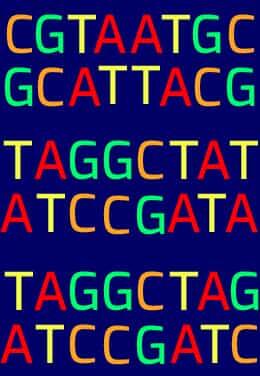Dividing and Multiplying with DNA
Before a cell divides, its DNA makes a copy of itself. This way, each of the two new cells will have matching sets of all 3 billion pairs of bases, in the same order. This all takes place inside the nucleus of each cell. The DNA spiral unzips and unwinds and the base pairs separate. All the Ts pull apart from the As, and the Gs pulls apart from the Cs. Also inside the nucleus are free-floating As, Cs, Ts, and Gs. These other new bases connect to the bases on each of the half-strands. All the Gs attract new Cs and all the As hook up with new Ts. Once each side has a complete set of base pairs, the new DNA molecules curl into the twisted ladder shape. Now the cell is ready to divide.
Types: Adenine, Thymine, Guanine, and Cytosine
Represented by: the letters A, T, G, and C
Shape: DNA is like a twisted ladder with steps that are made up of four bases called base pairs
Characteristics: A is always paired with T, T is always paired with A, C is always paired with G, and G is always paired with. . . you got it, C!
Importance: these bases form the genetic code for all living things

The four bases are only found in human cells.
Fiction
The DNA of all living things is made of the same four bases. These bases contain the genetic code for making whales, flies, trees, and even you!
A single gene can be made of thousands of bases.
Fact
Each gene gives complicated instructions to the cell. These instructions require lots of base pairs to tell the cell what to do.




 Biodiversity
Biodiversity
 Brain
Brain
 Genetics
Genetics
 Marine BiOLogy
Marine BiOLogy
 MicrobiOLogy
MicrobiOLogy
 PaleontOLogy
PaleontOLogy
 ZoOLogy
ZoOLogy
 AnthropOLogy
AnthropOLogy
 ArchaeOLogy
ArchaeOLogy
 Astronomy
Astronomy
 Climate Change
Climate Change
 Earth
Earth
 Physics
Physics
 Water
Water
